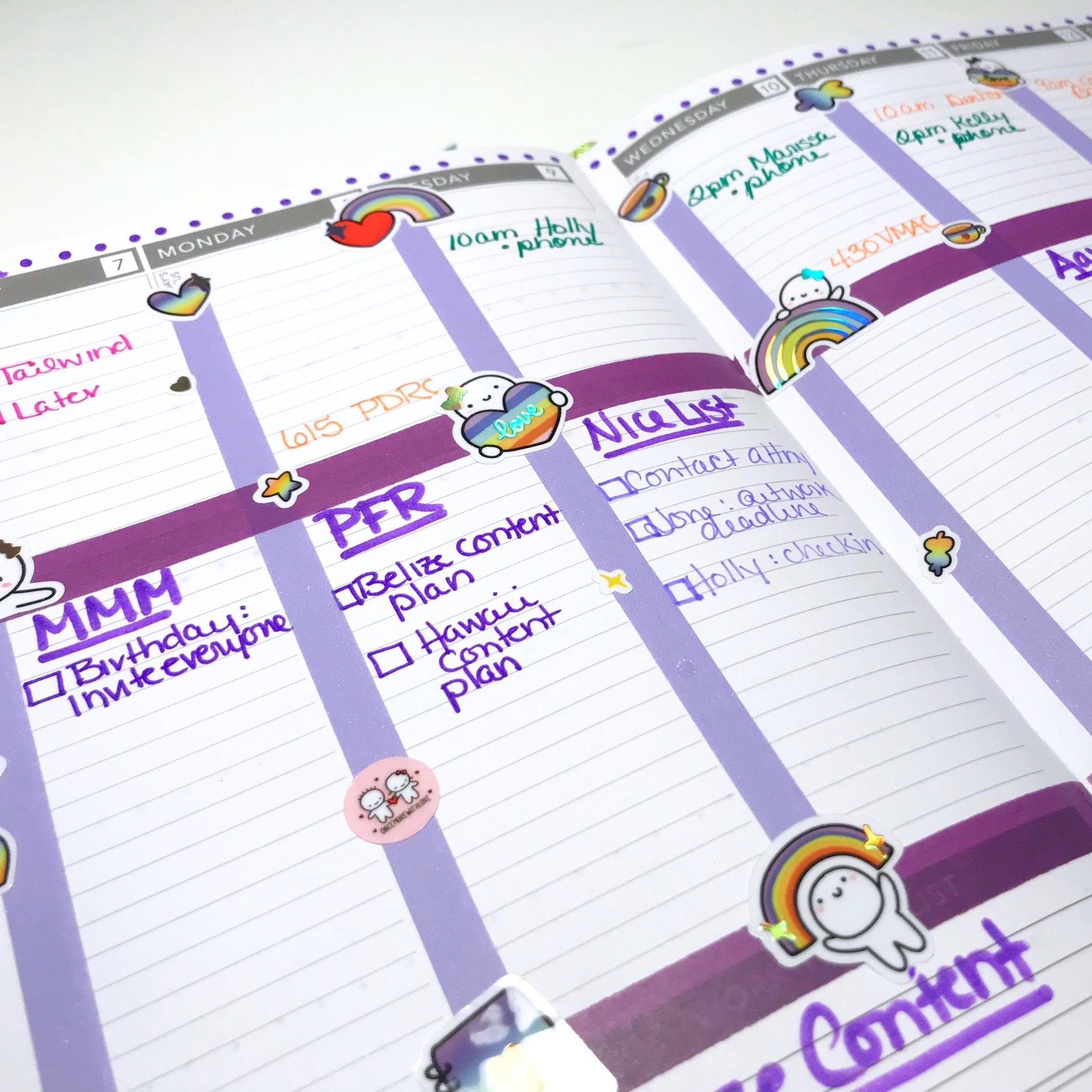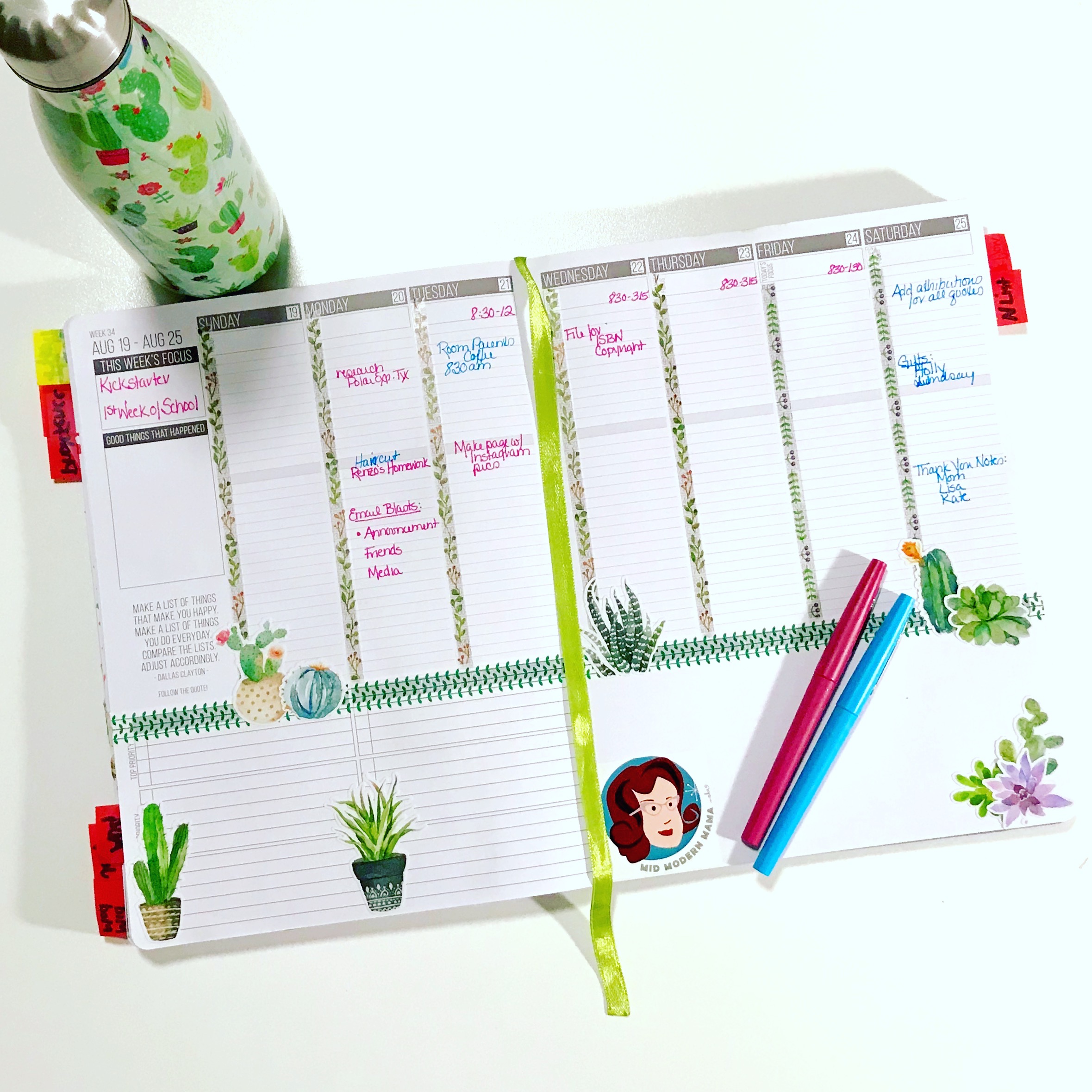How to Use a Planner
Daily, Weekly, and Monthly Habits to make Planning more effective
So you have chosen the perfect planner, but how do you use it? One approach is to just use it as your calendar: birthdays, events, appointments, assignments, tasks. That’s a start. And if that’s all you do, you will be more on top of your life than you were before. Bravo!
But by spending just a little more time, by being just a little more intentional with your planner -- turning planning into a practice -- you will achieve even better results in your life.
I use Passion Planners (two of them, actually). I have used them for years, and I absolutely love them! But these ideas work with almost any planner. However, if you are interested in a Passion Planner, click this link for a 10% off discount!
Planning isn’t just time management
What do I mean by “turning planning into a practice?” Well, I think of planning like mental yoga. It is an exercise. It is fairly low impact, and you work at your own pace. Soothing music helps. When you are done with a session, you may be a little sore. But if you keep at it, you become more flexible, more agile, more intentional, and more careful about your time and your talents.
Current brain research indicates that the physical act of writing down information — as opposed to typing on a computer or a phone — accesses deeper learning and understanding which means if you write it down you are more likely to learn and remember something.
But what does that have to do with planning?
Everything, actually. Planning is more than just running a calendar. Good planning is deep decision-making, setting priorities, and analyzing time and space. Seriously. It isn’t just managing school schedules and work priorities. If you are planning, you are making decisions about what is important and accommodating those things in your finite time. And making decisions about what isn’t important and isn’t worthy of your time.
That’s deep thinking. And putting it all down on paper gets you deeper into that thought process. That’s why I refer to my planning as a practice. It is mental yoga.
So, what is my planning practice?
Our lives are busy. So my planning practice is very intentional. It is also scheduled, habitual, and frequent. And I think those are important elements to any practice. If you only do yoga every three weeks, you won’t have the same results as a yoga practice that is three days per week. The same is true for mental yoga. So here’s what my monthly and weekly practice looks like.
Current brain and educational research shows that writing something down on paper is better than typing for memory and comprehension. The same applies to planning. Using a paper planner like the Passion Planner for monthly, weekly, and daily calendaring is better for time management. Simple ideas for how to use a planner and examples of layout and organization tips. Also: family, mom, work, school
My Monthly Planning Practice
Sometime about the 15th of the month I sit down and work on the monthly spread for the coming month. For example, on July 15, I look ahead and fill in the August calendar and think about my goals, obligations, and deadlines for August.
Why in the middle of the month before? Well, if you flip the page on August 1, chances are you are already behind. And I try to think in 4 week increments rather than in months. It is harder, but months are arbitrary. They end in the middle of a week and aren’t all the same length. But weeks always have seven days and are easier to plan around.
So take a little time in the middle of the month to look ahead. You will avoid those unpleasant page-turning surprises!
Organization for moms, school, students, and work is important. I like the Passion Planner, but you can DIY a planner with a printable and some simple supplies. Think about layout ideas and color code everything.
My Weekly Planning Practice
Every Sunday afternoon or evening I make a cup of tea, close the door to my office, put on some soothing music -- I love the Spa channel on iTunes -- and pull out my planner. Then I work through the same six steps in this order:
Washi tape and stickers decorate my Passion Planner spread.
Step 1: Decorate my weekly spread
I use stickers and washi tape, markers and colored pens. This is totally optional, but I find this creative act makes my planner more fun, and gets my brain in a more creative space for my planning session. It’s like a mental warm-up. You’ll find a list of my favorite supplies here.
Color coded events and appointments are added to the calendar section of my weekly spread.
Step 2: Write in Events
I transfer all events from my monthly calendar and online calendars to the weekly spread. Once I have done this, the weekly spread becomes my primary calendar for the week, and I live by it.
My focus block always contains measurable steps toward my annual goals.
Step 3: Check in on annual goals
I look at my annual goals and the steps I have outlined for those goals. Are they reasonable? Achievable? Still relevant? Done?
Task lists alone aren’t effective. They are sorted by project with blank space for developments as they arise.
Step 4: List Tasks by Project
Because I have multiple large, long-term projects going at once, I keep project-specific lists week-to-week. I transfer over any tasks that didn’t happen the week before, and set out the tasks for the week ahead. These tasks all support the over-all goals for those projects. For example, if it is the month when I’m sending The Nice List off to the printer, I may have distinct tasks for that week including proofreading, signing off on proofs, sending wire transfers, etc.
The bold purple notes at the top of each day indicate that day’s priority. This helps make decisions about time.
Step 5: Assign Priorities to Each Day
Once I know what needs to be done by the end of the week, and what obligations I have, I look at the days and decide which projects or tasks will be accomplished each day. I write these into the daily boxes. This eases a lot of anxiety!
By setting aside Wednesday to work on the presentation I’m giving on Friday, for example, I know that I have a priority -- and that I may need to decline other invitations or obligations on Wednesday to be able to get my work done.
Don’t be afraid to cancel events and to move tasks to the next week. I keep a post-it note handy for postponed tasks.
Step 6: Eliminate the Unnecessary
So many people forget that you can say “no!” But that’s what real, deliberate planning is about. Once you have I have my week laid out, I look for the waste, the conflicts, and the over-scheduling. And then I eliminate tasks, events, and obligations. We may only make it to swim team twice this week so that we can have family dinner on Friday night -- and that is ok. Time together as a family is more important. And my husband can take Bambino to that birthday party while I do the grocery shopping -- or if he can’t we will decline the invitation -- so that we can be sure to swim together on Saturday afternoon.
Your time is valuable. Your family time is precious. Safeguard it! If you aren’t planning and prioritizing, it is really easy to always say “yes” and to find yourself overwhelmed and overscheduled. By making a practice of eliminating events and obligations, you are making a practice of safeguarding the time that is most precious to you and your family.
Most weeks, my Sunday practice takes about an hour. My family knows this is sacred time. My husband knows he is often called in to coordinate schedules during that time. I am deliberate and open with Bambino about the importance of planning, and if he is awake, he is very respectful of my time. We talk openly about the fact that what I do for planning benefits all of us, and we don’t work as well as a family when it doesn’t happen. Planning time is sacred.
And at some point when Bambino is more involved in his own schedule and has homework and other commitments to juggle, I will invite him to plan with me, and I will teach him to plan, too.
My Daily Planning Practice
Every morning after I take Bambino to school, I grab a cup of tea and head down to my office. I work from home, so I leave my planner open on my desk as I am leaving my office. And in the morning the first thing I do is sit down with my planner and look at my day. Then I work through this process:
Weekly planning is more than organization. It is setting priorities and boundaries for yourself and your family.
Step 1: Note any Changes
I make any changes to the calendar, schedule, or priorities. Rather than running downstairs to make changes at 10 pm, I will set a reminder on my phone or send myself an email with the necessary information to deal with the next day.
Tips and ideas for how to use a planner with Passion Planner examples for Moms, men, work, school, and students.
Step 2: Review the Daily & Weekly Goals
Are they still reasonable? If not, I make adjustments.
Washi tape and stickers make a plain planner more fun. Color code events, tasks, and projects. Simple layouts and great pen suggestions for the best planner.
Step 3: Check off accomplished tasks
It is important to acknowledge what you have accomplished! I am careful to track what I have done which helps keep the feeling of being overwhelmed at bay. And I am not above writing down things I have accomplished -- and then checking them off. It’s important to acknowledge and track how you spend your time and energy.
This process takes about 5-10 minutes at the beginning of each day, and I’m careful to do this before looking at email or social media or launching in to a project. If I start my day centered and clear about my priorities, I’m much more likely to be productive and to accomplish what I set out to do.
All together my time commitment to planning looks like this:
Annual planning start: 2 hours one time in late December or early January
Monthly look ahead: 1 hour per month (around the 15th of the month)
Sunday look ahead: 1 hour per week
Daily planning: 10 minutes per day | 5-6 days per week
By carving out dedicated time for planning and by making a planning practice truly intentional, planning can change your relationship with time, your calendar, your family, work, and your entire life. All that in less than 2 hours per week.
And by working on paper you take maximize the efficacy of your planning. Planning on paper is a better workout for your brain. You will remember more, better hold to your priorities, and better manage your time.
As always, feel free to ask questions! And let me know how your planning practice is going!
Pin it!
Tips and ideas for creating a planner practice -- a kind of mental yoga to help boost memory and improve time management. Planning isn't just managing a calendar. It is setting priorities and making decisions which allow you more family time and better work-life balance. Includes organization tips, daily, weekly, and monthly calendar ideas, and examples including the Passion Planner. Also: moms


















